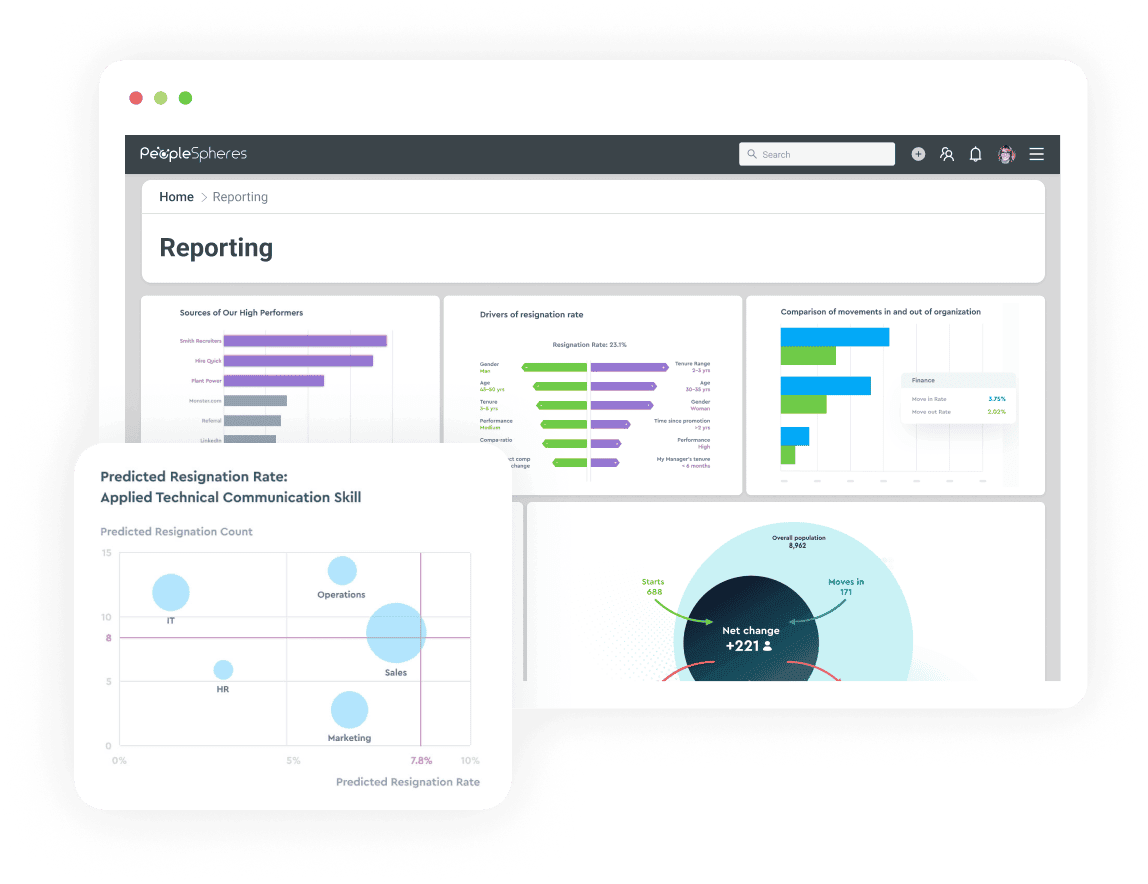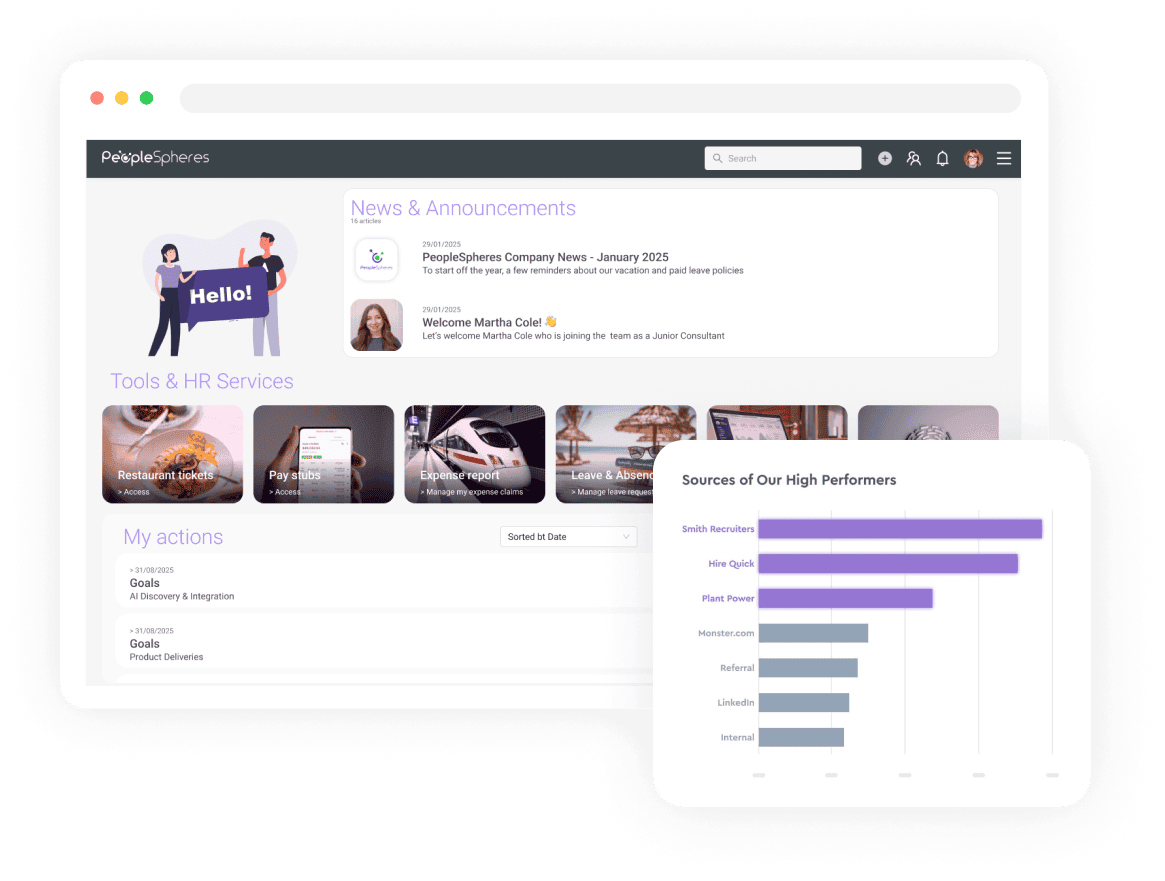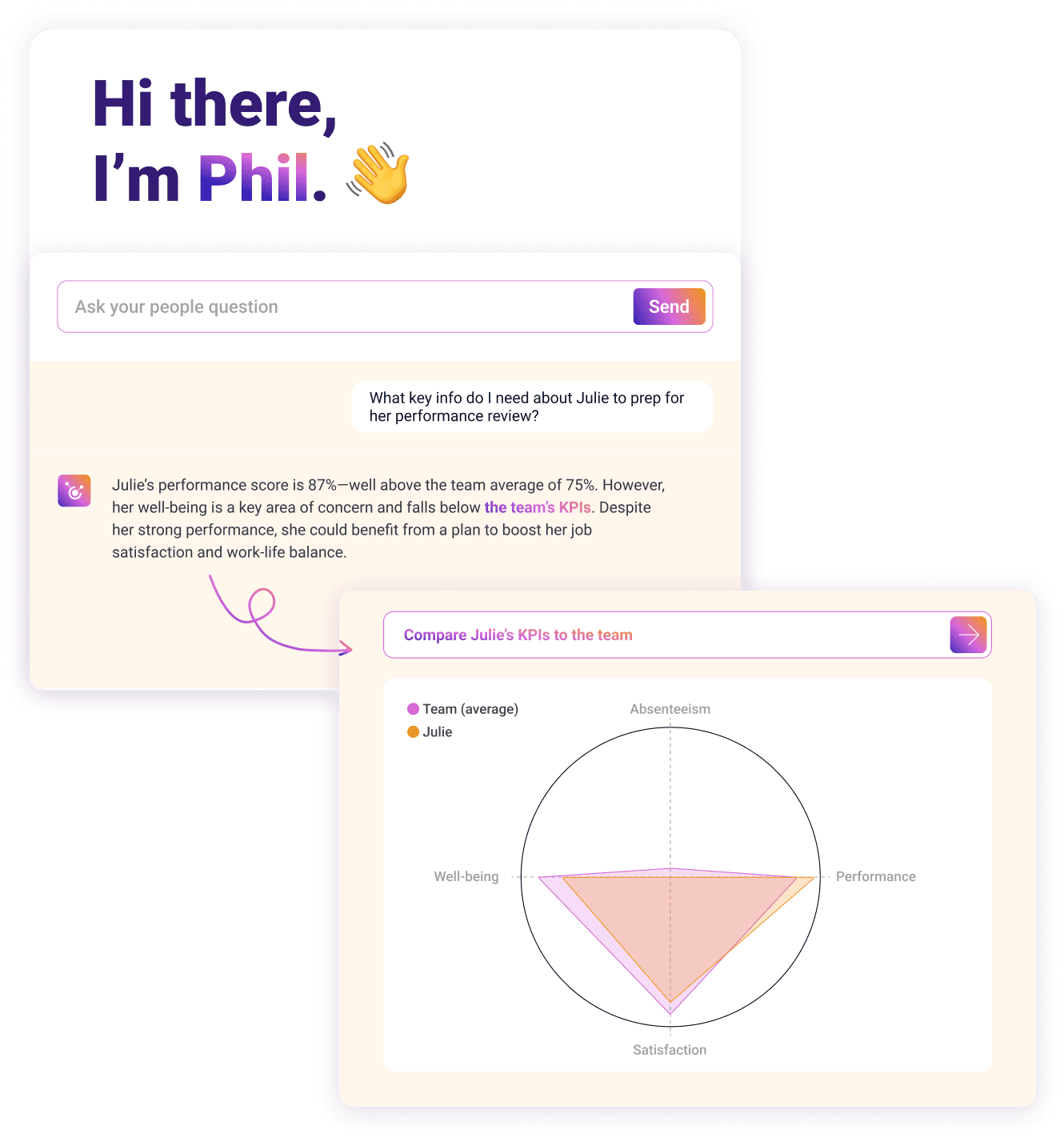Go from HR reporting to AI-powered analytics
With unified and secure data, businesses use PeopleSpheres to get fast and intuitive workforce insights.
Connected, trusted data
Move the needle on urgent business challenges. Bring all your HR data and systems together, ensuring your data is clean, connected, and immediately actionable.
Self-service analytics for non-analysts
Push insights to your managers at scale. AI makes insights accessible with natural language analytics. Ask questions in plain English. Get answers in seconds.
Turnkey, pre-built metrics
Get instant access to the metrics that matter most—headcount, retention, turnover, and more. Spend less time chasing numbers and more time leading change.
Labor market benchmarks
Our tool uses a data model backed by 250 million benchmarks. So yo can know exactly where you stand, where you’re headed, and how you compare to industry standards.
Powerful analytics — at scale
Putting the power of data in the hands of analytics teams and field managers alike
Data Manager
Data Manager takes HR analytics to the next level with ad-hoc reporting, custom dashboards, and the ability to simulate workforce outcomes.
Empowered by predictive analytics and HR benchmarks, it’s built for organizations needing detailed, flexible analysis to support complex decision-making.
Data Advisor (GenAI)
Data Advisor includes all the features of Data Manager, but with the added power of GenAI. Its natural language interface and auto-generated narratives make analytics approachable for everyone.
Ideal for organizations wanting to democratize data access while leveraging AI to simplify complex analysis.
Easy access to every piece of information you need to make sound decisions
Business decisions should be made based on data — not gut feelings. PeopleSpheres makes it easy by unifying data from every corner of your organization—HR, finance, operations, and more—into one powerful, unified platform.
- We handle the complexity, so you don’t have to. No more manual wrangling or endless spreadsheets.
- Our common data model ensures every piece of information speaks the same language—clean, reliable, ready to use
- Built to scale, our platform is secure, open, and adaptable, making it the foundation for smarter decision-making

Finally, intuitive insights you can push out across your organization
HR reporting isn’t just for the HR team. Managers across your organization need actionable insights to make better decisions, fast. PeopleSpheres makes that happen—at scale.
- Push real-time, role-specific insights directly to managers without overwhelming them with raw data
- Deliver prebuilt metrics and best practices content, so managers can focus on action, not analysis
- Empower leaders to move fast with rapid time to value—whether they’re addressing turnover, optimizing performance, or driving engagement

An HR-trusted search engine for all workforce answers
With PeopleSpheres, HR reporting is powered by AI for intuitive, accessible, and efficient analytics—even for the non-analyst.
- Ask questions, get answers: Natural, ad-hoc exploration puts the power of data in everyone’s hands
- Skip the noise: Focus on doing analytics, not reports
- Drive adoption at scale with a tool that is as easy to use as it is powerful


“The data is obviously not an end goal, but it is a way to bring performance, quality, and serenity to teams. Until recently, most of our tools were managed by fax and email, and a little with Excel files, so you can imagine the limitations.”
FAQs
What is PeopleSpheres and how is used for HR analytics?
+PeopleSpheres aggregates and cleanses workforce data from diverse systems, creating a unified and reliable data source. This unified data enables businesses to track critical metrics like turnover rates, retention, labor costs, diversity representation, and employee engagement without the hassle of manual data consolidation.
PeopleSpheres democratizes analytics by making it accessible to all levels of the organization. With intuitive dashboards, natural language analytics, and easy-to-use interfaces, managers and leaders can independently explore data and make informed decisions—no advanced analytics expertise required.
Built to grow with your business, PeopleSpheres can handle increasing data volumes and adapt to evolving organizational needs. The platform prioritizes data security with robust encryption, compliance with global regulations like GDPR, and role-based access to sensitive information.
Is PeopleSpheres suitable for organizations without a dedicated analytics team?
+Yes, PeopleSpheres is specifically designed to empower organizations without a dedicated analytics team. Traditional analytics tools often require specialized knowledge to extract, clean, and interpret data, but PeopleSpheres eliminates these barriers with its user-friendly and intuitive platform. Here’s how it supports organizations of all sizes and expertise levels:
- Self-serve analytics: PeopleSpheres allows HR professionals, managers, and other non-technical users to access and explore data independently. Its intuitive dashboards and prebuilt reports make it easy to navigate and gain insights without needing to rely on data scientists or technical teams.
- Guided analytics: The platform provides step-by-step guidance to help users understand and interpret data. This includes natural language prompts and explanations, ensuring even those unfamiliar with analytics can make data-driven decisions.
- Prebuilt metrics and benchmarks: PeopleSpheres comes with ready-to-use metrics tailored to common HR challenges, such as turnover rates, time-to-fill, cost-per-hire, and retention metrics. This eliminates the need for creating complex formulas or customizing dashboards from scratch.
- Data cleansing and preparation: PeopleSpheres automatically cleanses and organizes data, removing the need for manual data preparation or specialized technical knowledge.
What types of data sources can PeopleSpheres integrate?
+PeopleSpheres is designed to be highly versatile and flexible in its integration capabilities, allowing it to unify data from virtually any source. This ensures a comprehensive view of workforce dynamics and enables more informed decision-making.
Below are examples of of data sources PeopleSpheres can integrate:
- payroll systems
- applicant tracking systems (ATS)
- employee onboarding tools
- performance management systems
- talent management systems
- learning management systems (LMS)
- finance platforms
- operations software
- legacy and in-house systems
- and more…
What analytics are available for talent acquisition?
Hiring great talent is more than just filling positions—it’s about driving your organization’s future success. But when your recruitment process is siloed, reactive, and based on guesswork, you risk missing the mark. Enter PeopleSpheres —a solution designed to transform the way you attract and hire talent, with data-driven precision.
With prebuilt metrics and benchmarks, you get instant visibility into your recruitment pipeline. From tracking time-to-fill to understanding candidate conversion rates, you’ll have the numbers you need to measure success and identify gaps.
But we don’t stop at metrics. Our platform goes deeper, enabling you to predict and plan for future talent needs. Leveraging workforce outcome simulation and actionable analytics, you can see beyond the immediate challenges and align your hiring strategy with long-term business goals.
Recruitment shouldn’t happen in isolation. With unified data from HR, finance, and business operations, your talent acquisition efforts become part of a cohesive strategy. Understand the cost-per-hire, measure the ROI of your recruitment campaigns, and even uncover trends that help you make better hiring decisions—all in one place.
What analytics are available for employee retention?
Losing top talent doesn’t just hurt morale—it impacts productivity, disrupts teams, and eats into your bottom line. But with the right insights, you can turn retention from a challenge into a strength. PeopleSpheres helps you get ahead of turnover and take proactive steps to keep your best people engaged and committed.
We start with the fundamentals: prebuilt metrics that reveal what’s driving employee turnover. From resignation trends to retention by department, role, or manager, you’ll have instant visibility into the factors influencing attrition.
But understanding the “what” is just the beginning. PeopleSpheres empowers you to explore the “why”. Our platform connects data from across your organization—HR, engagement surveys, performance reviews, and more—so you can uncover patterns and pinpoint the root causes of attrition.
Ready to take action? With predictive analytics, you’ll gain the power to anticipate risk before it happens. Identify at-risk employees, understand what motivates them, and create targeted interventions to keep them on board. Whether it’s adjusting workloads, offering career development opportunities, or addressing engagement gaps, you’ll always be one step ahead.
And because retention is everyone’s responsibility, PeopleSpheres delivers insights directly to managers and leaders, tailored to their roles. Easy-to-use dashboards and natural language analytics ensure that anyone—not just HR—can understand and act on retention insights quickly.
What analytics are available for budgeting and workforce planning?
The success of your business goes beyond numbers—it’s about optimizing resources, forecasting costs, and ensuring your workforce aligns with business priorities. PeopleSpheres gives you the tools to connect workforce data with financial metrics, providing clarity, precision, and actionable insights for better decision-making.
With unified data across HR and finance, you can see the full picture of your workforce costs—total compensation, overtime, benefits, and more—all in one place. No more toggling between spreadsheets or struggling to reconcile conflicting reports.
But it’s not just about tracking costs—it’s about understanding them. With prebuilt metrics and best practices, PeopleSpheres helps you identify cost drivers, monitor budget compliance, and uncover opportunities to optimize spending.
Planning ahead? Predictive analytics makes workforce planning seamless. Model different scenarios, anticipate future costs, and align your budgets with strategic goals. Whether you’re planning for growth, responding to market changes, or preparing for a new initiative, you’ll have the insights you need to make confident decisions.
What metrics does PeopleSpheres provide to measure HR effectiveness?
Get access to the metrics that matter most, helping you measure, manage, and optimize HR performance like never before.
- Turnover Rates: Understand resignation trends and pinpoint the roles, departments, or teams with the highest attrition.
- Time-to-Fill: Track how long it takes to hire for critical positions and identify bottlenecks in your recruitment process.
- Cost-per-Hire: Measure the financial impact of your talent acquisition efforts and optimize for efficiency.
- Retention Rates: Monitor how well your organization is keeping top performers and uncover the reasons employees stay—or leave.
- Diversity and Inclusion Metrics: Ensure your workforce reflects your values by tracking representation, pay equity, and progression opportunities.
- Engagement Scores: Analyze employee feedback to identify areas where your workforce is thriving—and where it’s not.
- Absenteeism Rates: Discover trends in unplanned absences and their impact on productivity.
- Performance Benchmarks: Compare team and individual performance against goals to track progress and adjust strategies.
But tracking these metrics is only the first step. With PeopleSpheres, you can connect insights across systems, uncover patterns, and take action with predictive analytics and workforce simulations.
Turn your data into decisions—and your decisions into impact. With the right metrics and insights, HR becomes a strategic driver of growth and success.
Want better HR reporting today?
Have our teams guide you to find your answers